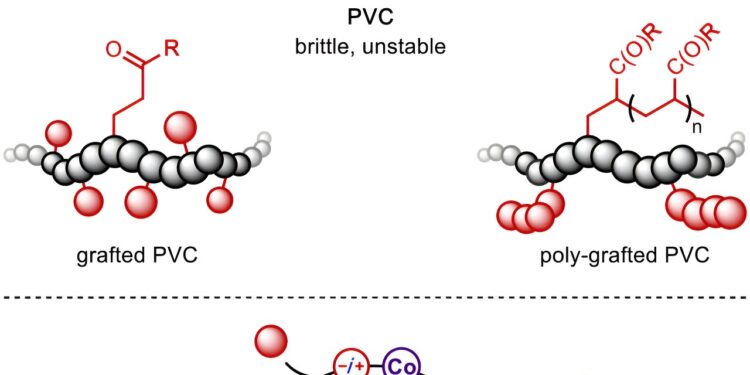Credit: Chemistry (2024). DOI: 10.1016/j.chempr.2024.08.021
Researchers have developed a way to make a type of plastic more durable and less likely to release dangerous microplastics. Their study identified a safe way to attach chemical additives to polyvinyl chloride (PVC). The work is published in the journal Chemistry.
Found in everything from toys to construction materials to medical packaging, PVC plastics currently rank as the third most used plastic in the world. Despite its widespread use, pure PVC is fragile and sensitive to heat, and manufacturers can only use it after stabilizing its properties with other chemicals.
However, these additives, or plasticizers, are only a short-term solution for stabilizing PVC. Over time, plasticizers leach from plastics, allowing the material to deteriorate into potentially harmful organics and microplastics. Now, a team led by Christo Sevov, the study’s principal investigator and associate professor of chemistry and biochemistry at Ohio State University, has discovered that using electricity to permanently attach these chemical additives can prevent such unwanted reactions.
“Instead of mixing these chemicals, our method involves chemically bonding the plasticizer compound directly to the PVC by grafting it onto the polymer backbone,” Sevov explained.
Modifying PVC molecules in this way allows them to become more durable and more resistant to chemical changes, ultimately leading to materials with more robust properties.
“This is really one of the few examples where there is this much control over changing the properties of PVC,” Sevov said. “So this is the first step to controllably modifying PVC to give it the properties you are interested in, whether it is hard, stretchy or soft.”
The team encountered some challenges; Modifications of synthetic polymers often fail because the reactions were initially developed for small molecule analogs, not large molecule analogs such as pure PVC. To solve this problem, the researchers optimized the catalyst they used in their process and, through trial and error, were able to overcome the problems that arise when editing large molecules.
In addition to making advances in organic chemistry, the team’s work also has implications for the environment, as limiting how quickly plastics degrade can go a long way toward curbing the release of microplastics (tiny pieces of plastic debris) in our environment.
Today, scientists know that these particles, which are known to pollute the air, water and our food supplies, are harmful to both humans and wildlife. The average person probably ingests between 78,000 and 211,000 of these particles each year.
But as experts begin to understand the long-term impact of microplastics on Earth, organic chemists are racing to find ways to phase them out of everyday life, Sevov said.
“Many chemists are shifting their efforts to the study of large molecules and the development of new chemicals for recycling, recycling and modification of well-known polymers,” he said. For example, trying to recycle PVC products can cause further degradation of the material due to the high temperatures needed to turn the plastic into something else, so the process is not very efficient.
But by using Sevov’s method, “you can potentially reuse the material many times before it really starts to break down, improving its lifespan and reusability,” he said.
In the future, more control over which materials will be safe for consumers will be possible once efforts to repair PVC leaks can be reliably scaled up, something the study highlights and which, for the moment, is possible with their method alone.
“There’s no better way to do it at the scale you would need for commercial PVC modification, because it’s an immense process,” Sevov said. “There is still a lot of work to be done before we solve the microplastics situation, although we have now laid the groundwork for how to get there.”
Other Ohio State co-authors include Jordan LS Zackasee, Valmuri Srivardhan, Blaise L. Truesdell and Elizabeth J. Vrana.
More information:
Jordan LS Zackasee et al, Electrocatalytic grafting of plastics in polyvinyl chloride, Chemistry (2024). DOI: 10.1016/j.chempr.2024.08.021
Journal information:
Chemistry
Provided by Ohio State University
Quote: Scientists develop new method to strengthen PVC products (October 3, 2024) retrieved October 3, 2024 from
This document is subject to copyright. Except for fair use for private study or research purposes, no part may be reproduced without written permission. The content is provided for informational purposes only.



